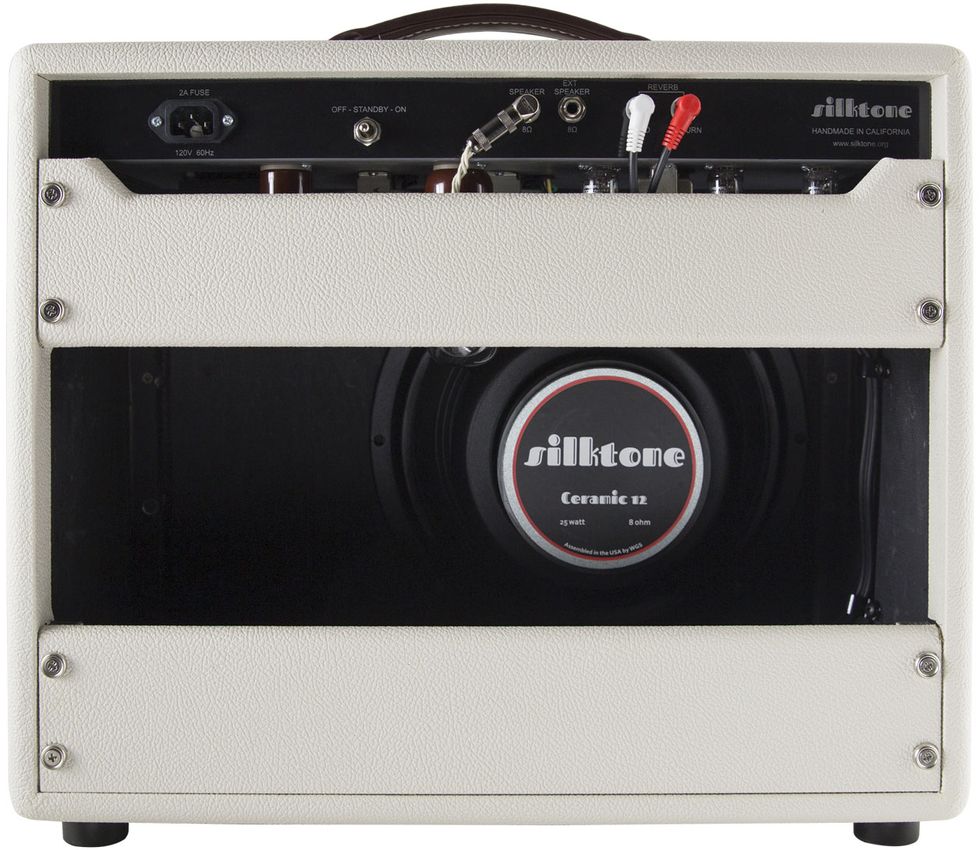RatingsPros:A great range of great tones. Phenomenal dynamic response. Beautiful build. Thrilling tone stack-bypass mode. Immersive reverb. An inspiring instrument with a unique voice. Cons: Not cheap. No traditional power lamp—don’t forget to turn it off! Street: $2,199 as reviewed with ceramic speaker (alnico speaker $200 extra) Silktone Amp silktone.org | Tones: Ease of Use: Build/Design: Value: |
Until now, the Silktone company’s focus has been high-end cables. Their eponymous Silktone amp is their first foray into amp production. And man, it’s one formidable foray!
The Silktone is a gorgeous 12-watt handwired combo with a single 12" speaker, powered by a single KT66 power tube. In other words, it’s that rare bird: an honest-to-goodness class A amp.
Class Act
Guitarists love debating what constitutes class A. The best-known true class A amp is the tweed Fender Champ. Gibson and Supro also produced memorable single-tube amps. Amps with multiple tubes are generally class AB, though some models, notably ones from Vox and Matchless, are biased in ways that conjure the characteristics of a class A amp and are sometimes referred to as such.
And what are those characteristics? Class A power sections transition more smoothly and readily into distortion relative to AB amps. That distortion tends to generate richer overtones, a property often described as “chime.” Overdriven sounds have a complex and electrifying high end. Class A amps can also sound richer at low volumes.
Route KT66
The Silktone exemplifies the harmonic complexity and crackling presence of class A. But another factor is power tube choice. Unlike the tweed Champ, with its relatively low-powered 6V6 tube, the Silktone employs a big KT66, which is roughly equivalent in power to an EL34. But the KT66 is more “hi-fi” than that iconic Marshall tube. There’s less classic-rock midrange grind, but you get lower lows, higher highs, and more headroom.
The results are stunning. Tones have a glorious shimmer regardless of gain level. Clean settings are glassy in a good way, reminiscent of a fine tweed Champ. With the volume pushed, tones continue to glisten as they fatten. Champs can get thin and screechy when cranked. Not here! High-gain tones are fat and pleasantly compressed without sacrificing their shine. (If you like, you can substitute a 6L6, 6V6, or EL34 without modifications or re-biasing.) By necessity, tubes in class A designs aren’t as loud as the same tubes in AB designs. But the Silktone’s 12 watts sure seemloud. Its levels are probably sufficient for unmiked small gigs with a restrained drummer.
A Vision in White
The Silktone looks gorgeous—especially clad in the white vinyl of our review model. (It’s also available in red and black.) The amp’s look is vaguely reminiscent of a ’60s Fender combo, especially with its brownface-style knobs. Its most striking visual feature is the wave-shaped wooden panel that frames the slightly offset custom speaker built by Warehouse. (The ceramic-magnet speaker in our review sounds grand. But you can also order an alnico version for $200 extra.) Another handsome detail is a subtly backlighted logo in lieu of a traditional red lamp. The only drawback: In daylight, it can be hard to tell whether the amp is on. Still, you’d have to be a terminal space case to inadvertently leave the amp on all night—you know, like I did.
Workmanship is top-notch throughout, from the solid birch cabinet to the skilled handwiring. Top-shelf components are laid out on traditional turret board, and connected with Silktone’s own cotton-covered wire. (Remember, Silktone is a cable company, too.) The transformers are custom models from Magnetic Components, with old-school paper wrap. And damn, the spring reverb! It’s got the feel of a vintage Fender tank, but with uncommon wetness and depth. It’s not often you encounter a tank that can get too wet for surf rock! There are independent mix and dwell (duration) controls.

Stack Attack
The 3-band tone stack also has a Fender flavor, but with an unusually wide-ranging mid control. With the mids pulled back, the amp does an excellent imitation of a vintage Fender blackface, with its deep scoop and well-defined lows—things you might not expect from a class A combo. My first demo clip showcases various settings, using a mix of single-coil, humbucker, and lipstick tube guitars.
But my favorite thing about the tone stack is the fact that you can bypass it. I swear, if there’s one rare amp feature that I wish was common, it’s this. Most amp tone circuits are passive. They can only remove frequencies, not add them. When they’re bypassed, you get more level and impact. Here, a toggle selects between Chiffon mode (tone stack engaged) and Raw Silk (bypassed). The latter mode is beautifully balanced, and the dynamic response is breathtaking. The second clip employs my “don’t make me come over there” test. I set the volume near maximum, sat across the room, and shape the sound solely by touch and guitar volume knob adjustments. It was a thrilling experience.
The Verdict
The Silktone epitomizes everything that’s exciting about class A designs. The tone controls are beautifully voiced—especially the wide-ranging mid pot. The dynamic response is phenomenal, especially when you bypass the tone stack in Raw Silk mode. It’s beautifully made from beautiful parts. I love this inspiring instrument and its uniquely commanding voice.









![Rig Rundown: Russian Circles’ Mike Sullivan [2025]](https://www.premierguitar.com/media-library/youtube.jpg?id=62303631&width=1245&height=700&quality=70&coordinates=0%2C0%2C0%2C0)

















